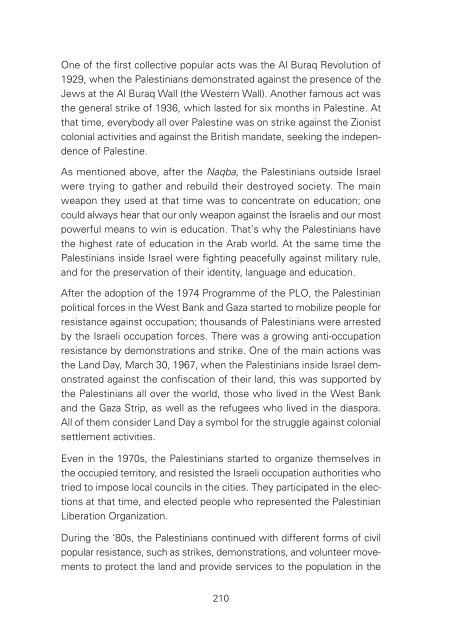The Contribution of Women to Peace and Reconciliation
The Contribution of Women to Peace and Reconciliation
The Contribution of Women to Peace and Reconciliation
Create successful ePaper yourself
Turn your PDF publications into a flip-book with our unique Google optimized e-Paper software.
One <strong>of</strong> the first collective popular acts was the Al Buraq Revolution <strong>of</strong><br />
1929, when the Palestinians demonstrated against the presence <strong>of</strong> the<br />
Jews at the Al Buraq Wall (the Western Wall). Another famous act was<br />
the general strike <strong>of</strong> 1936, which lasted for six months in Palestine. At<br />
that time, everybody all over Palestine was on strike against the Zionist<br />
colonial activities <strong>and</strong> against the British m<strong>and</strong>ate, seeking the independence<br />
<strong>of</strong> Palestine.<br />
As mentioned above, after the Naqba, the Palestinians outside Israel<br />
were trying <strong>to</strong> gather <strong>and</strong> rebuild their destroyed society. <strong>The</strong> main<br />
weap on they used at that time was <strong>to</strong> concentrate on education; one<br />
could always hear that our only weapon against the Israelis <strong>and</strong> our most<br />
powerful means <strong>to</strong> win is education. That’s why the Palestinians have<br />
the highest rate <strong>of</strong> education in the Arab world. At the same time the<br />
Palestinians inside Israel were fighting peacefully against military rule,<br />
<strong>and</strong> for the preservation <strong>of</strong> their identity, language <strong>and</strong> education.<br />
After the adoption <strong>of</strong> the 1974 Programme <strong>of</strong> the PLO, the Palestinian<br />
political forces in the West Bank <strong>and</strong> Gaza started <strong>to</strong> mobilize people for<br />
resistance against occupation; thous<strong>and</strong>s <strong>of</strong> Palestinians were arrested<br />
by the Israeli occupation forces. <strong>The</strong>re was a growing anti-occupation<br />
resistance by demonstrations <strong>and</strong> strike. One <strong>of</strong> the main actions was<br />
the L<strong>and</strong> Day, March 30, 1967, when the Palestinians inside Israel dem -<br />
onstrated against the confiscation <strong>of</strong> their l<strong>and</strong>, this was supported by<br />
the Palestinians all over the world, those who lived in the West Bank<br />
<strong>and</strong> the Gaza Strip, as well as the refugees who lived in the diaspora.<br />
All <strong>of</strong> them consider L<strong>and</strong> Day a symbol for the struggle against colonial<br />
settlement activities.<br />
Even in the 1970s, the Palestinians started <strong>to</strong> organize themselves in<br />
the occupied terri<strong>to</strong>ry, <strong>and</strong> resisted the Israeli occupation authorities who<br />
tried <strong>to</strong> impose local councils in the cities. <strong>The</strong>y participated in the elec -<br />
tions at that time, <strong>and</strong> elected people who represented the Palestinian<br />
Liberation Organization.<br />
During the ‘80s, the Palestinians continued with different forms <strong>of</strong> civil<br />
popular resistance, such as strikes, demonstrations, <strong>and</strong> volunteer move -<br />
ments <strong>to</strong> protect the l<strong>and</strong> <strong>and</strong> provide services <strong>to</strong> the population in the<br />
210








